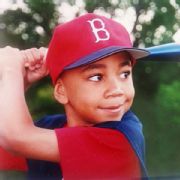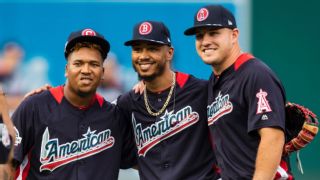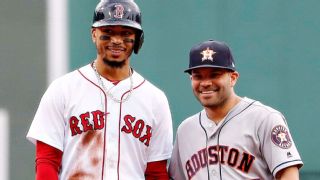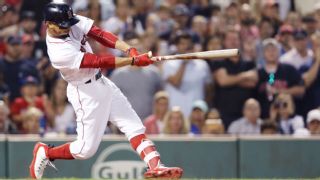|
The best player on baseball's best team is built to be underestimated. Xander Bogaerts remembers the first time he saw Mookie Betts. It was late summer 2011 in South Carolina, and Bogaerts was an 18-year-old shortstop for the Low-A Greenville Drive -- a confident kid who'd signed as an amateur free agent in 2009 and was two years from a World Series title with the Boston Red Sox. Also on the field in Greenville that day was Betts, a recent high school graduate who'd been taken in the fifth round of the MLB draft that summer and was in town for a workout with other Red Sox prospects. From a distance, Bogaerts studied Betts -- all 5-foot-9, 165 pounds of him. "He was short," Bogaerts says now. He watched Betts do some fielding drills, throw a little. "I didn't think much of him. I was not impressed," the Red Sox shortstop remembers. So thoroughly uninterested was Bogaerts that day that he can't remember whether he stuck around to watch Betts take batting practice. Seven years later, with his team rolling toward the American League East title, Bogaerts stands in the visiting clubhouse in Kansas City and sizes up his teammate from across the room. He admits he should have been more open-minded toward the pint-size player he saw in South Carolina. "Maybe I would have seen it," Bogaerts says. The it, of course, is the immense talent of No. 50, the now-25-year-old (and 180-pound), three-time All-Star who is leading Boston to perhaps its most impressive regular season ever; one of the game's shortest players has transformed into one of this generation's greatest offensive weapons. Bogaerts gestures toward Betts and laughs. "We all see it now."
Mookie's mother, Diana Benedict, was a middle infielder on her high school's softball team who loved the game so much that her grandfather built a ball field on his Kentucky farm. When Mookie first showed interest in playing baseball, Diana wanted things done right, so she decided she would coach her boy. For Mookie, even as a 6-year-old, doing things right meant competing hard and leaving everything on the field. But as she prepared for her son's first coach-pitch game, all Diana could think about was Little Mookie leaving his pants on the field. "My baby was so scrawny," she remembers, "even though he ate all the time." She'd bought him extra-small baseball pants, but even those were too big. A belt made the fabric bunch too much. So Diana went back to the store in search of something, anything, that might solve the issue. She eventually found some Teenage Mutant Ninja Turtles suspenders, which matched the Ninja Turtles glove she'd already bought for Mookie. On game day, she snapped the suspenders onto her son's pants, pulled the Turtles over Little Mookie's pipe-cleaner arms and prayed. "He wore those suspenders on the outside of his jersey," Benedict says, proudly. "He was styling." She can't remember the results from Little Mookie's first game, except one: The pants didn't budge. "We didn't have any problems after that," Mookie's mom says. In spite of his size, he was a star on that team and on every one after it. As the stacked Red Sox push toward the most wins in the franchise's 118-year history -- with men like Bogaerts and J.D. Martinez and Chris Sale -- Betts is the team's engine, its true north, guiding the team toward the postseason. "He can hit, he can hit for power, he can run, he scores runs, he drives them in," Red Sox left fielder Andrew Benintendi says. "How many teams have an all-around weapon like Mookie?" "I think we're looking at a possible Hall of Famer," Bogaerts says. "Mookie's probably been our best player here. Since David [Ortiz] left, he's our guy." Still, how many times over the past five seasons -- in this age of 100 mph pitchers, of three true outcomes and of every at-bat hinging on the anticipation of the flash-bang of bat on ball, of trajectory and distance -- has someone looked at Betts and wondered: How can he put up those numbers with that body? "Mookie's size doesn't matter," Benintendi says. "It's all about how you use what you have." It's impossible to overstate Betts' role on this Boston team. Through Thursday, he'd posted the highest overall WAR (10.2) and second-highest offensive WAR (8.0) in baseball -- behind only Mike Trout. He hit his 30th home run in Boston's division-clinching win over the Yankees on Thursday, and 30 steals are on the horizon. He has the major league's highest batting average. An MVP award is a real possibility. Not that statistical self-reflection is a priority for Betts, who insists he doesn't look at his numbers, that he's more interested in an opposing pitcher's 2-2 slider than what his average is on a Tuesday night in Baltimore. He has spent his entire life being the little guy, so asking about his size doesn't interest him, either. "Wherever I go, there will be guys who are bigger and stronger than me," he says. "But that doesn't mean they can outwork me or that they're better than me. If you're good, it will show. I'm not the size of Trout or Bryce Harper. God gave me ability and I have to work to let it show." If the Red Sox make a run at their fourth title in 15 years, they'll do so with Betts at the top of baseball's most potent lineup. Some of the game's smallest shoulders now carry its biggest expectations.
Call it a revolution, this Little Big Bang. This is now the era of the short guy, when those power-hitting galoots and their 36-inch pant legs get kicked to the curb. In baseball, 5-9 is the new 6-4. Consider: The wins above replacement leaderboard is loaded with men who might have trouble reaching the top shelf at the grocery store's cereal aisle. While players like the New York Yankees' 6-7 Aaron Judge and 6-6 Giancarlo Stanton got most of the preseason hype, it's Betts and Cleveland's equally compact Jose Ramirez -- the first player since 2012 to break into baseball's 30/30 club -- who've been smashing stereotypes and homers all summer. Had Houston's 5-6 Jose Altuve not injured his right knee in July, the 2017 American League MVP would be in the conversation for this season's best all-around small guy -- which has turned into a debate about the game's best overall player. They come with burgeoning power and on-base pedigrees, hardly the spunky slap hitters scouts would have typecast just a decade ago. "Those guys can just flat-out hit," says Altuve's Astros teammate George Springer, who gets a regular dose of the two other American League stars. "They can hit anything you throw at them." Since the expansion era began in 1961, only eight times has a position player 5-9 or shorter complied an OPS+ of 155 or better in a season. Two such seasons belong to Altuve. Two others belong to Betts and the 5-9 Ramirez. When it comes to overall WAR the past two seasons, the trio owns three of the top four slots among position players. "Baseball has become a sport where size doesn't matter anymore," says Benintendi, who stands at 5-10. "That big-guy era, or whatever you want to call it, seems like it's faded away. That's good for short players like us." Sitting in front of his desk before a game this summer, Red Sox manager Alex Cora takes stock of the shorter guys in his clubhouse and across the league. A total of 1,368 players have appeared in a game this season through Wednesday. Just 42 are 5-9 or shorter. Including Betts, Boston has employed five of them this season and consistently starts one of the major league's smallest outfields, with Betts, Benintendi and 5-10 Jackie Bradley Jr. Then there are Altuve and Ramirez.  Are those guys -- and players like Ozzie Albies, the Braves' 5-8 rookie All-Star, who had 22 homers through Thursday -- busting the short-guy stigma? Cora, a comparatively towering 6-foot infielder back in his day, laughs. "Maybe now the big guys are the ones breaking the mold," he says. With their success, Betts, Ramirez and Altuve already are serving as new standards when it comes to analyzing and developing short players. "So much of scouting is based on past experience and reference points, and we've primarily only had slap-hitting little guys to compare short, amateur players against," says Mike Gange, a Chicago White Sox scout who was partly responsible for persuading his team to select Oregon State's 5-7 Nick Madrigal with the fourth overall pick in June's MLB draft. Madrigal, who would go on to win the 2018 College World Series with the Beavers, is the shortest first-round pick in major league history. "Altuve and Betts and Ramirez are making the sample size bigger for us," Gange says. "More than ever in this game, we can truly evaluate a player outside his appearance." Still, overcoming past biases will take time. Three years ago, Gange -- who's 5-6 himself -- was coaching a summer-league club in the West Coast League and faced Madrigal's team. When Gange saw the undersized teenager step up to the plate for the first time, he instinctively moved in his outfielders. Madrigal ripped a double over the left fielder's head. Thinking it was a fluke, Gange did the same thing on Madrigal's next at-bat. "Nick put that one in the left-center gap," Gange says. "And that's all because I was caught up in a stereotype." But why are some of the smallest players now producing some of the most colossal offensive results? "The simplest explanation is smaller guys are building their bodies in the offseason in ways they haven't before," says Matt Lisle, a hitting coach at the University of Missouri who works with Daniel Descalso, a 5-10 infielder who has hit 23 home runs over the past two seasons with the Diamondbacks, equaling his combined total from the previous seven years. "Altuve and the rest are not weak guys," Lisle says. "You see Betts, and he's swinging with intent. When these guys decide to go after the ball, they want to do damage." And don't discount perhaps the biggest variable for any athlete in any sport: innate ability. Alan Nathan, a professor emeritus in physics at the University of Illinois, has studied hitters for decades and says bat-on-ball success has little to do with a player's size (or lack of it). "So much of this stuff is above the neck," he says. Not surprisingly, players of any stature who see the ball best, who can process spin and movement correctly, have the most success. "In a brief moment when the ball's coming at them, they're digging through their memory bank," Nathan says. "What have similar balls done that they've seen over thousands of pitches? Does the spin resemble something they've seen before?" Synapses fire, muscles are signaled. Says Nathan: "And height doesn't play a part in any of that."
Sitting in the dugout an hour before a game this summer, Red Sox hitting coach Tim Hyers marvels at the evolution of Betts' game this season. "You have some guys who just want to be in the majors, and you have guys who want to be great players," Hyers says. "Then there's Mookie. Mookie doesn't want to be great. He wants to be the best." Betts was an All-Star, finished sixth in AL MVP voting, won his second Gold Glove and recorded 6.4 wins above replacement in 2017. But his .264 batting average was the worst of his career, he dropped 22 points on his isolated power from the previous season and his power to the opposite field was nearly nonexistent. "It definitely didn't look like the same Mookie," Hyers says. Hyers, who joined Cora's staff after previous manager John Farrell was fired last October, worked with Betts for years as the Red Sox's minor league hitting coordinator. Back then, Hyers marveled at Betts' hand-eye coordination and strike-zone awareness, his ability to figure out how to get on base and not strike out. "From the second you saw Mookie, it was obvious he was going to become an on-base machine," Hyers says. During spring training, he showed Betts videos of his 2017 at bats. Betts had suffered several injuries -- to his thumb, knee and wrist -- which Hyers thought sapped the outfielder of his power and changed his hitting mechanics. In particular, Betts' bat through his hitting zone was too parallel to the ground on contact, an angle that didn't meet the ball on an even plane. The swing made it especially difficult to pull balls with power or to punish pitches on the outer half of the plate for opposite-field drives. "Mookie was too direct and on top of the pitch," Hyers says. "He was putting a lot of good balls into the ground. I wanted him to meet the point of the ball and put it into the air because that's where he was going to be most effective." Hyers also urged Betts to be more aggressive, explaining that his patient approach and propensity to give away early strikes had made it too easy for teams to decode him. Pitchers, Hyers told Betts, had thrown him roughly 200 more sliders in 2017 than in 2016 -- pitches that were hard to square up. "We needed to move Mookie from passive takes because it was making him less dangerous as the at-bat went on," says Cora, who was Houston's bench coach last year and studied Betts' scouting report. "You could get ahead of him, expand a little bit away and then he would run out of bat. He would put the ball in play, but he wasn't going to kill you. "We had to tell him this year, 'From pitch one, you have to have intent.'" Betts took their tutelage to heart. "My job in this lineup is to swing the bat, and I had to trust that when I put the bat on the ball, good things would happen," Betts says. "We worked on this in the spring. Then I brought it to the game. I rolled with it and I saw results. It's something that happened quick." Through April, as Boston surged to the top of the AL East standings, Betts slashed .344/.439/.733. Perhaps most impressive was the power he generated with each swing. Betts' exit velocity jumped 3.8 mph to 92.2 this year. His OPS has skyrocketed, along with launch angles off his bat. His number of "barreled balls" -- i.e., perfect contact -- has more than doubled from last year. While he consistently pulls balls and showcases his power, he also has raised his efficiency on the outer half of the plate. In his previous four seasons with the Red Sox, Betts had just two opposite-field homers. This season, he already has hit three. The improvement has been dizzying. One of baseball's best players became even more lethal at the plate. "Mookie learned a new mindset, but I don't think this is a new baseball player we're seeing now," Cora says. "This has been in him the whole time. Mookie will say he can still be a lot better."
Freeing Mookie to be Mookie has raised the ceiling on his ability and allowed him to see his own statistical possibilities, beyond simply being the little guy at the top of the lineup who gets on base. "I think I've changed," Betts says. "It's one of those things I've just got to stick to." One at-bat from earlier this season encapsulates exactly why Betts 2.0 is so dangerous. Boston was down 2-1 to the Toronto Blue Jays on July 12 at Fenway Park when Betts went to the plate in the fourth inning with two outs and the bases loaded. Then-Blue Jays left-hander J.A. Happ pounded a first-pitch fastball inside. It was over the plate's inner half, a perfect pitch for Betts to pounce on and show off his newly discovered aggression. Instead, he let it blaze past him for strike one, a flashback to Mookie, version 1.0. "I don't think Mookie sees him that well," a surprised Dennis Eckersley said from his perch in the NESN television booth. Happ threw a ball on the next pitch, then came back with a 1-1 fastball that sent Betts stumbling across the plate as he swung and missed. Had Mookie's Magic finally run out? Happ rubbed the ball and looked toward the plate like a medieval executioner preparing to raise the ax. The fourth pitch was a jam shot. Betts barely got the handle on it, dumping a blooper into foul territory beyond first base. Toronto first baseman Justin Smoak anticipated the ball and darted toward the stands, extended his glove ... and watched the ball bounce off the leather. Betts had a second life, but he looked overwhelmed. With two strikes, he fouled back Happ's next pitch, a chest-high fastball. He adjusted the red plastic baseball-bat necklace a young fan had given him at spring training. Happ waited, then backed off the rubber. The crowd booed. Betts took a chop with his bat, resettled in the batter's box, then sneered at the pitcher, the left corner of his upper lip arched. You could almost hear the growl. Happ's next offering, an 88 mph changeup, was away, perfectly placed -- exactly the kind of pitch that would have ended this at-bat 10 months earlier. Instead, Betts flicked his bat, got just enough wood to bounce the ball foul between his legs. He then fouled off the next pitch, another 1-2 change in almost the same spot. As Happ grabbed a new ball, sweat glistened on his face. His 10th pitch was a slider, his first of the at-bat. It bounced inside. Again, Betts arranged the necklace. Everyone at Fenway could feel it, the weight of the moment, the importance of what they were witnessing. This was more than one at-bat. This was a test Betts needed to pass. At 2-2, Happ threw another fastball, this time low and inside. Betts checked his swing; he fouled the ball off the catcher's glove. Happ bounced a 55-foot changeup off his catcher's midsection with the 12th pitch, pushing the count full. The lefty had challenged every part of Betts' zone. He'd gone to the fastball, the changeup, the slider. He was out of gas. "Here we go," Eckersley said. "It's time to party, right here." Betts' at-bat ended seven minutes and 14 seconds after it began. Last season -- maybe any other season of Mookie Betts' career -- it would have ended in ball four, a stroll to first, a game-tying RBI. But Betts didn't watch this one. He loaded his hands, lifted his front left leg and began his swing. It was compact and powerful, a whoosh of lumber that took less than two-tenths of a second from start to finish. He pulled a 95 mph fastball that was low and inside toward left field, on a perfect 28-degree angle off the bat. It reached a speed of 108.3 mph, rocketed up and over the Green Monster, out of Fenway and onto Lansdowne Street. For a brief moment, Betts lost his mind. He flipped the bat and screamed. The coolest, calmest man on the field -- the player built to disappear in a clubhouse -- was suddenly charging toward first base, flexing, tripping over himself with delirium. As he rounded first, he pounded his chest, yelling toward the Red Sox dugout. He crossed home plate and raised his arms, then jumped once, twice, before being engulfed by high-fives and forearm pounds. Back in the dugout, Betts -- who would later call it the most satisfying at-bat of his major league career -- made his way from one end to the other, through a mass of men bigger and taller and stronger. In that instant it became clearer than at any other time this season: Mookie Betts might be a small man, but he's built for big moments.
|


